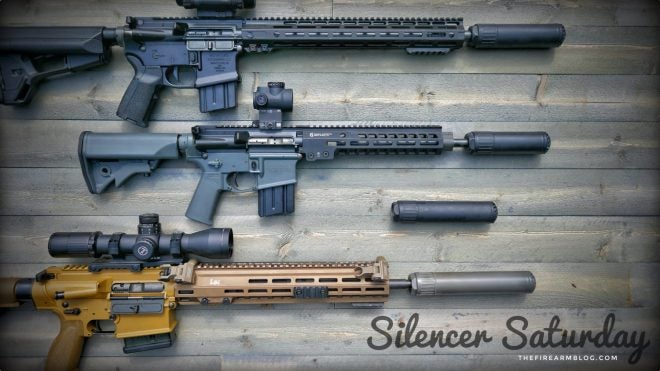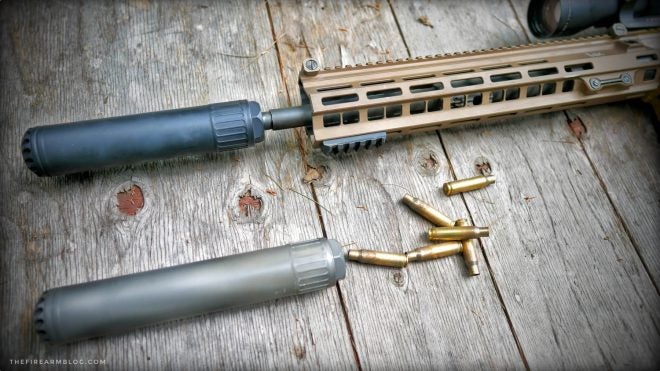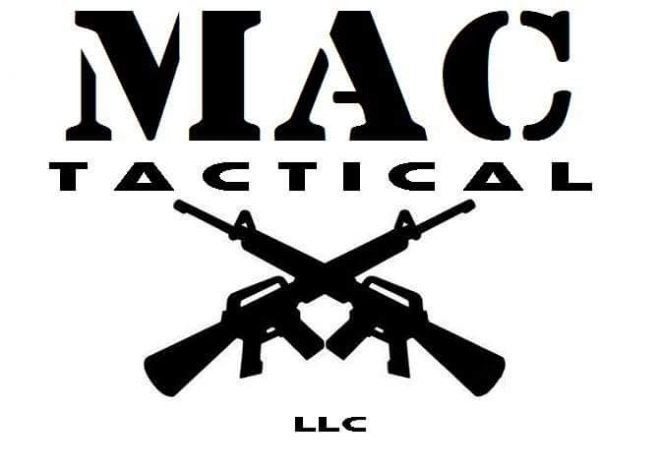Good afternoon everyone and welcome to TFB’s Silencer Saturday, where even the best ear plugs are left at home. Today we finally finish metering the latest OSS Suppressors Helix models on a small variety of hosts. As you may remember from our conversation a few weeks ago, OSS’s claim to fame is better at-ear suppression versus the more traditional MILSTD muzzle suppression levels. This is accomplished in part by a baffleless core that directs gasses forward and out vents at the muzzle end of the silencer (Flow-Through Technology). The result is a suppressed host that should have less “blowback” without the need for adjustable gas systems to tune the rifle. But do OSS’s claims hold up under real-world independent testing? Let’s find out.
SILENCER SATURDAY #35: Metering The Latest OSS Suppressors
OSS loaned TFB four suppressor models for testing: The HXQD 556k, HXQD 556, HXQD 762 and the HXQD .338 Magnum Ti. We looked at some of the specifications and details last time, but additional information can be found on the OSS website. They also loaned us an awesome “battle rifle“ host: the H&K CSASS rifle chambered in 7.62X51.
Almost everyone agrees that decibel metering at the ear is a more modern and functional way of determining suppressor performance. I say almost because, as we have seen in past discussions, government testing has previously focused on MILSTD muzzle readings and the magical 140dB “hearing safe” threshold to evaluate suppressors. Without igniting a firefight, I will say that even though at-the-ear decibel testing seems common sense now, companies that focus on MILSTD muzzle readings aren’t necessarily wrong, they are just providing performance based on a customer specification or requirement. For example: if the The U.S. Military wants silencers that meter at or below 140dB at the MILSTD muzzle location, companies may choose to focus on that requirement.
But physics is a nasty little minx: all those gasses trapped inside a suppressor are fighting for a way out, even if they have been slowed down a bit due to internal geometry. A generous bore, or even vents like we see in the OSS models, can allow gas to escape forward and away from the shooter. A tight bore (and lack of vents can force gases back down the barrel and gas tube (direct impingement AR15/AR10 platform) reducing at-the-ear suppression levels. Larger diameter (more volume) silencers as well as baffle geometry can also help prevent “blowback”.
For the sake of comparison, I metered the OSS models both at the MILSTD muzzle location as well as the at-the-ear location.
Reminder: Observations posted here are specific to the time, location and hosts available. A tester at a different location or with different host weapons could record different observations for the same silencers. In addition, decibel readings are a small part of the decision process when shopping for a new silencer. Know your requirements and do your own research.
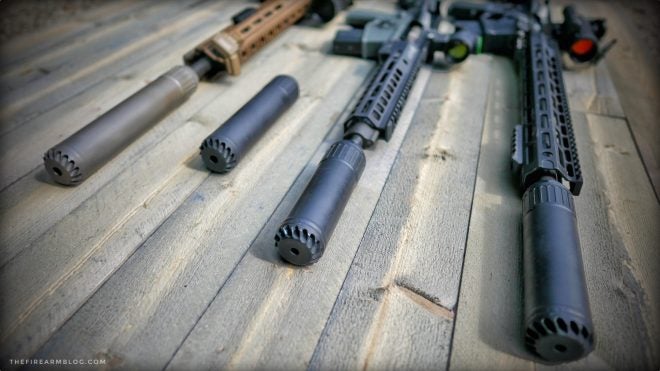
Let’s look at the numbers.
Variables and Equipment:
- 72 degrees
- 62% humidity
- B&K 2209 – A Weighted
- Calibrated and tested c/o Allen Engineering
Model: OSS HX-QD 556K
Host: Dynamic Defense 12” Sierra
https://dynamicdefensedevelopment.com/product/sierra/
Ammunition: Federal 62gr M855
MILSTD Muzzle
- 140+
- 152.5
- 151.4
- 152.3
- 151.9
- 150.9
- 151
- 150.4
- 150.7
- 150.8
At The Ear
- 141
- 141.7
- 142
- 140
- 140.3
- 142.2
- 142.4
- 141.1
- 143.1
- 142.5 BHO
Model: OSS HX-QD 556
MILSTD Muzzle
- 149.5
- 142.6
- 142.
- 143.7
- 143.9
- 144.6
- 143.5
- 144.6
- 143.9
- 144.2
At The Ear
- 140.6
- 141
- 142
- 141.5
- 140.4
- 140.5
- 139.2
- 138.1
- 139.5
- 138.1 BHO
Model: HX-QD 762 (5.56 Host)
MILSTD Muzzle
- 150+
- 144.9
- 146.1
- 144.6
- 143.9
At The Ear
- 141.5
- 141
- 140.5
- 140.6
- 139.7
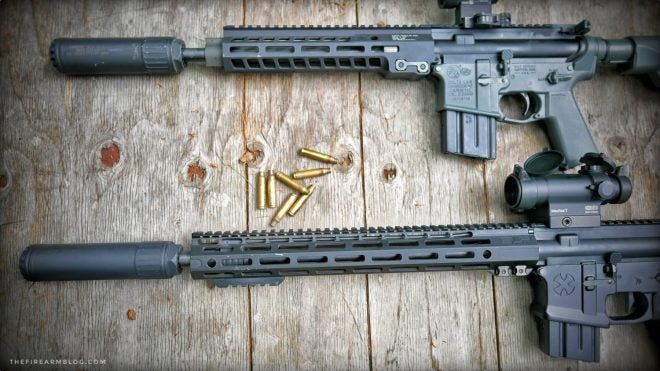
HOST: Dynamic Defense 16” Romeo
https://dynamicdefensedevelopment.com/product/romeo/
Model: HX-QD 556K
Adjustable Gas Block: FULLY CLOSED
MILSTD Muzzle
- 150+
- 144.6
- 144.9
At The Ear
- 140.8
- 140
- 138.1
Adjustable Gas Block: 8 CLICKS OPEN
MILSTD Muzzle
- 148.6
- 145
- 146.3
- 144
- 145.1
- 144.5
- 145.7
- 147.6
- 147.7
- 145.9
At The Ear
- 141.6
- 139
- 142.1
- 139.5
- 142.6
- 142.4
- 139
- 142.1
- 144.5
- 142.6
- 140.7
Model: OSS HX-QD 556
MILSTD Muzzle
- 145.8
- 137.1
- 140.7
- 138.1
- 140.8
- 138.3
- 138.7
- 138.9
- 139.6
- 139.8
At The Ear
- 139.5
- 140.1
- 141
- 140.5
- 142
- 140.4
- 141.9
- 140
- 140.1
- 140.7 BHO
Host: H&K CSASS Rifle – 7.62×51
Model: OSS HX-QD .338 MAGNUM Ti
Ammunition: ZQI 147gr FMJ
MILSTD Muzzle
- 149.9
- 144.4
- 144.9
- 146.4
- 145.7
- 144.7
- 147.2
- 146.8
- 147
- 149.1 BHO
At The Ear
- 138.1
- 136.9
- 138
- 136.8
- 139.1
- 135.9
- 138
- 139
- 136.2
- 137.9 BHO
Model: Oss HX-QD 762
MILSTD Muzzle
- 150+
- 146.9
- 147
- 146.6
- 146.8
- 146.4
- 146.5
- 145.6
- 147.4
- 148.1
At The Ear
- 137.2
- 135.1
- 137.
- 139.9
- 137.2
- 136.8
- 137.2
- 137.1
- 136.9
- 136.1
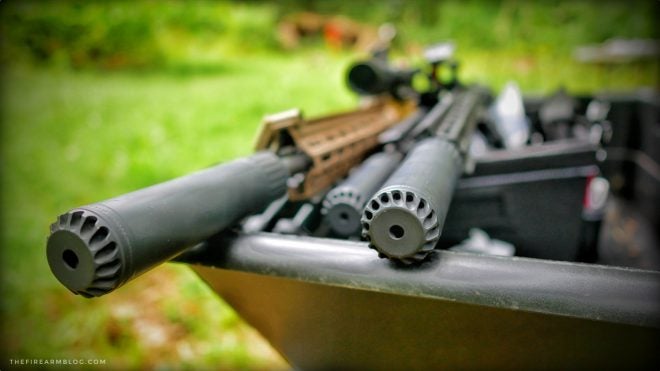
Observations and Conclusions:
Overall, in my limited testing, all of the OSS models performed very well, especially at the shooter’s ear test location. Even the short 556K, while showing the loudest numbers of the bunch at the muzzle, had respectable numbers for the at-the-ear location.
The “equilibrium point” seems to be the 556 model on the 16” barrel, where MILSTD muzzle and at-the-ear numbers were very close to each other. Also interesting was the fact that the extra volume of the 762 model did not provide much additional suppression over the smaller 556 model.
And the 762 model held its own against the Magnum Ti model, even sometimes out performing the longer silencer. But at-the-ear performance between the two silencers on the CSASS rifle was negligible.
The latest generation of OSS Suppressors appear to be real performers that provide excellent suppression at the shooter’s ear. The weight of the silencer as well as the muzzle device is a bit higher than I’d like to see, but in the end, the suppression levels from the Helix series are worth of a hard look if you are in the market for a rifle suppressor.
Gone are the days of what I perceived as gimmicky, over complicated hexagon sleeves and two part systems. I am impressed.
MSRP: $879-$1499 depending on the model.
Next Week: Allen Engineering
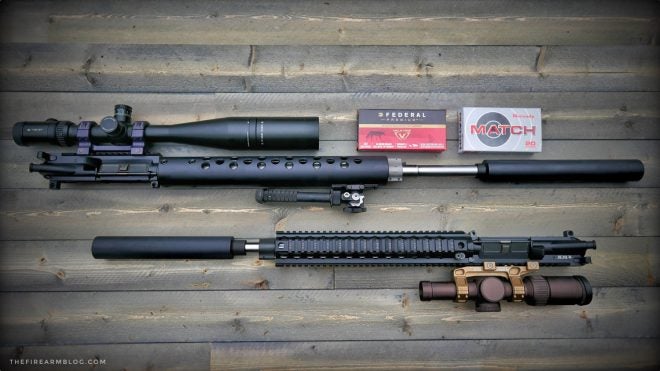
 Your Privacy Choices
Your Privacy Choices
